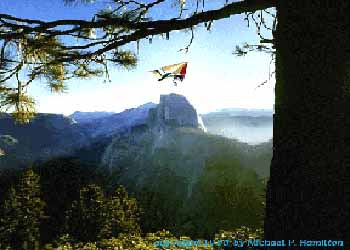|
|

© copyright 2003 Michael P.
Hamilton, Ph.D.
To soar like the condors

December 9, 1996:
With my Powerbook nestled safely on my lap, I peered from
my Black Mountain perch and watched the sky for evidence of the approaching
storm front. On the display of the computer was the latest enhanced
satellite image of California (courtesy of the NOAA web site), graphically
portraying the varied patterns of rain-bearing clouds pulled along by
the approaching wave of low pressure. The storm was already bombarding
the Central California coastline with warm pacific rain, and giving
every indication that it was heading our way. Concentrating on the details
of the image and my "real-time" view of the northwest sky,
my attention was momentarily distracted by an unusual sound. Looking
up I was surprised by a pair of Red-tailed Hawks who were using the
strong ridge lift generated by the approaching storm to hover within
20 feet of my head. Wind pushed over and under their smooth wings provided
them all the lift they needed to remain motionless and nearly silent
as they observed me, perhaps satisfying their curiosity or apprehension
that I was not going to harm them. The nearly inaudible vibration of
their wing feathers was all that gave away their presence to me.
Watching the hawks soar and hover, my mind was drawn to
a scene from my memories. It was nighttime during the summer of 1975,
and a small group of friends and I were clandestinely working our way
up a back country trail in Yosemite National Park towards the summit
of El Capitan, one of the most famous rock faces in all of North America.
El Capitan is viewed by thousands of people a year, while an elite minority
of enthusiasts chooses to climb the 3,593 foot vertical face using only
ropes, chalks, and their wits. We were determined to be the first people
to ever throw ourselves off the top -- in hang gliders!
When we were seasonal wilderness patrolmen with the State
Park in 1973, Bob Smead and I ran into a couple of guys who had hiked
from Humber Park to the top of San Jacinto Peak with hang gliders, intending
to jump off the summit. Then there were no laws against hang gliding
in the wilderness, why recreational hang gliders had only been invented
shortly before that time, and few people were thought to be crazy enough
to consider jumping from an 11,000 foot mountain. Bob and I didn't know
what to do with these guys, they were clearly exhausted from their efforts
at carrying two 80 pound gliders so many miles. So we helped them take
their load to Round Valley, and suggested that perhaps the escarpment
near Hidden Lake would be a good spot to launch. The pilot seemed happy
about this alternative, and gave me one of his business cards with the
invitation that Bob and I contact his hang gliding business so he could
give us flying lessons.
Their flight was successful (although they ended up flying
off of the water tower next to the Tramway), and after a summer of free
lessons, I wrote them a check for a brand new Wills Wing Hang Glider.
So began a ten year adventure of flying off local mountain peaks, soaring
with hawks along the sea cliffs of San Diego, and jumping from several
of the Yosemite Park "Big Walls" including Glacier Point.
I found myself doing things that I would never have considered possible
had I not been learning from the best pilots in the world. The hike
up El Capitan was arduous to say the least, but when we woke up in the
morning to a clear sky and calm air, our hearts began to soar like the
condors we emulated while we assembled our gliders and prepared for
the flight. Gradually the air began to rise from the Valley floor and
the first of our group of five pilots took a half-dozen or so running
steps and launched themselves into 4,000 feet of vertical air space.
The butterflies I felt in my stomach seemed to help me gain an extra
amount of lift as I earned a view of Yosemite Valley that only four
others in the entire world had ever seen, suspended beneath the rugged
aluminum and dacron of my condor-shaped hang glider.

previous journal entries
|